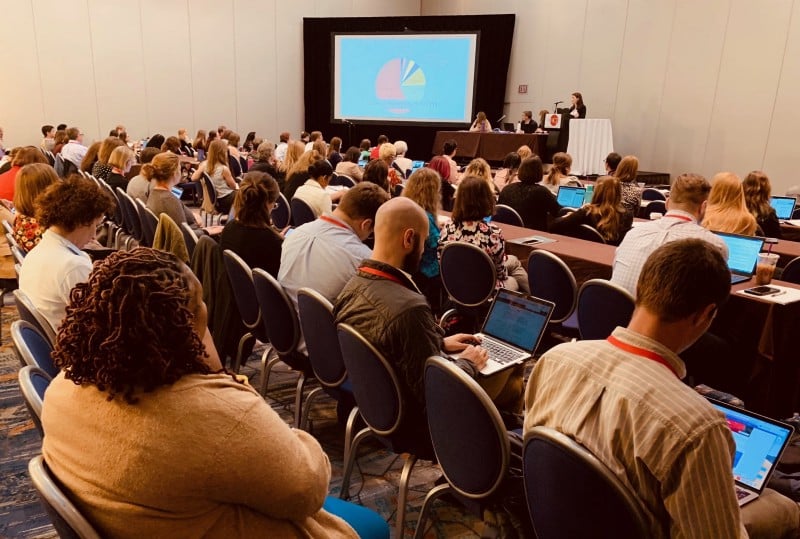Photo courtesy of Cynthia H. Craft.
An award-winning USA Today reporter talks about why she’s covered child death for so long
It’s been nearly 23 years, but USA Today reporter Jayne O’Donnell won’t ever forget the moment.

After writing a series of articles in 1996 that prompted the federal government to make airbags safer for children, a group representing the families of the 26 children who had died invited O’Donnell to their first meeting.
They presented O’Donnell with 26 long stem roses, each one representing a dead child. “Nothing has ever been so powerful,” O’Donnell said.
Decades later, O’Donnell has covered all manner of child death causes — from dangerous consumer products to, more recently as the USA Today’s healthcare policy reporter, tween and teen suicide. She co-founded the Urban Health Media Project to give kids a voice.
O’Donnell invited Evermore founder Joyal Mulheron to attend the Association of Health Care Journalists’ annual conference in Baltimore and participate in a workshop session aimed at helping reporters generate health story ideas and provide research sources and techniques to support their work.
In this Q&A, O’Donnell shares more about her work, why she’s felt compelled to report and write about child deaths and why Evermore has an important story to tell.
Q: Tell us how you got started covering the death of children.
In the late 80s, I was asked to write about the auto industry from the Washington, DC, perspective. Because that was regulation, it immediately got into safety and environmental issues. … And child deaths have always really resonated. It just strikes a nerve with people. There’s no tolerance for anything that kills children.
People seem to move on fairly quickly from some of the other deaths of older people, even 20-somethings. But young kids getting killed became a theme of my reporting, partly because it was very unusual at the time for women to be writing about cars at all. In all the years I wrote about cars, I still can’t really write a cohesive explanation of what makes them run. But I never cared to.
I was really writing from a woman’s perspective and more of a mother’s or father’s perspective long before I became a mother. …
When you start interviewing people who have lost children, that stays with you and has always stayed with me — never being able to imagine what it’s like to be those people.
Q: How can we create greater awareness about the public health crisis bereaved parents and families face?
Recognize that reporters have so little time. You guys have to have the numbers, the trends and the victims available to make it really easy for reporters to write. It’s so hard to get the time to do a project on something like this … And keep the stories out there.
Q: What stories have really stuck with you?
After the airbag story, I co-authored a two-part series on teen driving deaths, and that was really the story that made me become even more obsessed with the concept of how do you get over the loss of a child.
[As part of that series], I had lunch with two women who were featured on the front page of USA Today. Their daughters were 17 or so and had been in a car with two young men. The car crashed and both of their daughters died and one of the boys died, but not the driver. I had lunch with them a year after the crash and the one mother cried almost through the entire lunch, a year later. She couldn’t really leave the house. I was like, wow. I couldn’t even imagine.
Then, I found auto safety too narrow and expanded to cover the Consumer Product Safety Commission. I covered kids product safety — window blinds strangling kids, the cords on the baby monitors strangling kids, a lot of different products that were killing kids.
Right before I had my daughter, my only child, in 2000, I did a series on the company called Cosco. They were hiding the complaints about cribs collapsing and hurting kids. That just terrified me too. When my daughter was born, I used to lie in bed, saying, ‘Oh my God, her crib is going to strangle her.”
Q: What interests you about the work of Evermore and Joyal?
I also had a high school friend who carried a baby to term and then her baby died hours after the baby was born. I knew that she had always included a mention of the child on Christmas cards and was still affected by it. That would be now 30 years later.
So, the fact that Joyal was focusing so closely on grief and related issues really appealed to me.
Q: What are the challenges for reporters covering issues like child death?
There’s so much pressure to write about the latest thing. In a downsized newsroom you can’t spend much time writing about the aftermath of one shooting when another shooting has happened. It’s difficult to do the kind of important aftermath stories that are needed.
One of the other challenges is this: If it hasn’t happened to you, you wouldn’t think of it. … Just the fact that there are more than 19 million parents in this country who have lost a child is fascinating to me. In Barbara Bush’s new biography by USA Today reporter Susan Page, they talk about how affected they were their whole lives by the loss of their daughter at an early age. People forget that.
Q: Why was it important for Joyal to be on the panel?
Because infant and child mortality are such important issues, I think that people need to think of new ways to write about them.
Q: How can Evermore get the word out?
Recognize that reporters have so little time. You guys have to have the numbers, the trends and the victims available to make it really easy for reporters to write. It’s so hard to get the time … And keep the stories out there.
Editor’s note: And that’s exactly why we’ve launched this blog and are working hard to spread the word about the devastating effects on parents and families when a child dies.
The numbers and research are stark:
71% of surviving siblings suffer serious health consequences after the death of their brother or sister.
Parents suffer job and income loss, isolation, marriage and relationship strife, poorer health and even shortened lives after their child dies.
Medical professionals agree that parents and siblings experience a “medical event” after the death of their child, brother or sister. Research shows that they actually are biologically and psychologically altered.
There is a disparate impact on black and Hispanic parents. By age 60, black parents are twice as likely to have experienced a child’s death than white parents.
And while all signs point toward a public health crisis, there are so many ways to help these grieving parents and families — from changes to the Family Medical Leave Act so families can take the time they need to grieve to training educators to safely help students express their grief.
At Evermore, we look forward to sharing the data and the personal stories that will help make changes for the families who desperately need it.

